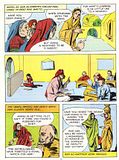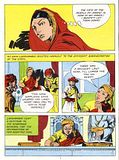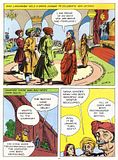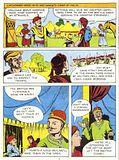
Rama's Ancestry
The Sun Dynasty or Solar Dynasty or Suryavansha is one of the most prominent dynasties in the history of Hinduism, along with the "Chandravansha" or Lunar Dynasty.
"Suryavanshi" means a person belonging to this dynasty. This clan was the eldest and the most prosperous in ancient India till the rise of Magadh in the 6th century BC. Ayodhya, the city founded by Vaivasvata Manu son of Vivasvan or Vaivasvata, was their capital.
The full lineage from Brahma is given in the Ramayana by Valmiki, other important sources are the Mahabharat, the Ramayana , the Bhagwat Purana & the Raghuvamsha of Kalidasa
The List of Monarchs
The following is the list, in chronological order, of the monarchs of the solar dynasty. Most of them were rulers of Ayodhya and therefore, Kings of Kosala.
According to Bhagwat Purana, Brahma created sage 10 sages using his mental powers -Marichi, Atri, Angiras, Pulastya, Pulaka, Kratu, Vasishtha, Prachetas or Daksha, Bhrigu, Nārada., one of whom was Marichi.
Kashyapa, the son of Marichi and Kala, is regarded as the father of humanity. His sons from Aditi, the sky goddess, and the daughter of Daksha Prajapati are called Adityas (Sons of Aditi), they were, Aṃśa, Aryaman, Bhaga, Dhūti, Mitra, Pūṣan, Śakra, Savitṛ, Tvaṣṭṛ, Varuṇa, Viṣṇu, and Vivasvat or Vivasvan.
Vivasvan or Vaivasvata (one of the sons of Lord Sun) - the Sun God, progenitor of the clan. His parents were the sage Kashyapa, father of all beings, and Aditi, Aditi's 12 sons, the Adityas, are the sun deities, and both Vivaswan and Aditya mean sun. Therefore another name for Vivaswan is Surya or the Sun, hence the name, Suryavansha. Vivaswan's sons include Shrraaddev and Shanishchar. The river Tapi was named after Vivaswan's sister Tapti.
- Manu or Vaivasvata Manu - the King of all mankind and the first human being. (According to Hindu belief there are 14 Manvantaras; in each, Manu rules. Vaivasvata Manu was the seventh Manu. Manu is referred to as a Rajan (King) in the Shatapatha Brahmana scripture. He founded the town of Ayodhya. He had nine sons, Vena, Dhrishnu, Narishyan, Nabhaga, Ikshvaku, Karusha, Saryati, Prishadhru, Nabhagarishta and one daughter, Ila, who was married to Budha of the Lunar Dynasty). He left the kingdom to the eldest male of the next generation, Ikshvaku, who was actually the son of Manu's brother Shraaddev.
- Ikshvaku - the first prominent monarch of this dynasty, giving the dynasty its another name the Ikshvaku dynasty. He had one hundred sons. Fifty of them ruled Uttarapath (Northern India) and fifty ruled Dakshinapath (Southern India).
- Vikukshi - He is said to have eaten the meat of a rabbit at the time of Shraddha and was known as Shasad. (Some records claim him to be grandson of Ikshvaku.) His son was Kakuthsa or Puranjay.
- Kakutstha or Puranjaya - He was a brave king and fought in the Devasur Sangram. His original name was Puranjaya. But after he annihilated Asuras (demons) while sitting on the hump (Kukud) of a bull, he was known as Kakuthstha, which means seated on the hump. His dynasty was also known as Kakuthstha after him.
- Anena or Anaranya
- Prithu
- Vishvagashva
- Ardra or Chandra
- Yuvanashva I
- Shravast - He founded the town of Shravasti near Kosala.
- Vrihadashva
- Kuvalashva - He killed a Rakshasa named Dhundh. It is said that Dhundhar region and the Dhund river are named after Dhund. Eighteen of Kuvalashva's sons died in the battle with Dhund. Thereafter, Kuvalashva was called "Dhundhumara".
- Dridhashva
- Pramod
- Haryashva I
- Nikumbh
- Santashva
- Krishasva
- Prasenjit I - His daughter Renuka was married to sage Jamdgni. She was mother of Parashurama.
- Yuvanashva II - He was married to Gori, daughter of the Chandravanshi king Matinaar.
- Mandhata - He became a famous and Chakravarti (ideal universal ruler) king. He defeated most of the other kings of his time. He married Bindumati, a daughter of the Chandravanshi king.
- Purukutsa - He performed the Ashwamedha Yajna (horse sacrifice). He married Nagkanya "Narmada". He helped Nagas in their war against the Gandharvas.
- Traddasyu
- Sambhoot
- Anaranya II
- Trashdashva
- Haryashva II
- Vasuman
- Tridhanva
- Tryyaruna
- Satyavrata or Trishanku - His original name was Satyavrata, but he committed three (tri) sins, and hence got the name Trishanku. First, while he was a prince, he misbehaved and was temporarily exiled from the kingdom. Next, he killed the milch cow of his preceptor Vasishta. His third sin was that he used the unsanctified meat of his kill as food. Trishanku also had a desire to ascend to heaven in his mortal body. After Vashistha refused him this boon, since it is against nature to ascend into heaven as a mortal, the sage Vishwamitra, Vashistha's rival, created another heaven for him, called "Trishanku's Heaven", and located in mid-air. His sons were Dhundumara, and Harishchandra, who was borh of the princess of "Kaikaya" named "Satyaraksha".
- Harishchandra - He is known for his honesty, truth and devotion to duty or Dharma.
- Rohitashva - He was the son of Harishchandra. He founded town of Rohtas Garh in Rohtas district, Bihar and Rohtak, originally Rohitakaul, meaning from the Kul (family) of Rohit
- Harit
- Chanchu
- Vijay
- Ruruk
- Vrika
- Bahu or Asit - He was attacked and defeated by another clan of Kshatriyas. After this, he left Ayodhya and went to the Himalaya mountains to live as an ascetic with his queens. At that time Yadavi queen was pregnant with Sagara.
- Sagara - He recaptured Ayodhya from the "Haihaya" and "Taljanghi" Kshtriyas. He then attempted to perform the horse sacrifice, Ashwamedha Yajna. However, the sacrificial horse was stolen by the god Indra on the south eastern shores of the ocean, which was at that time an empty bed with no water in it. At least sixty of Sagara's sons died attempting to recover the horse, also causing great destruction by their reckless search. Puranic legends say the number of his sons was 60 thousand.
- Asmanja - Sagara's surviving son was not made king due to his bad conduct.
- Anshuman - He was the grandson of Sagara, and his successor as king. He did penance in an attempt to bring the holy river Ganges to earth, that she might wash away the sins of his ancestors.
- Dileepa I - He also tried to bring Ganges to earth, but also failed.
- Bhagiratha - Sagara's great-grandson, after strenuous penances, at last succeeded in bringing Ganga down from heaven. When she flowed over the remains of his ancestors, their souls were redeemed, and the ocean was refilled. Ganga also bears the name "Bhagirathi", in honour of his deed.
- Shrut
- Nabhag
- Ambarish - According to Buddhist legends, he went to Tapovana to be a renunciant but after a public outcry returned and ruled for some time.
- Sindhu Dweep
- Pratayu
- Shrutuparna
- Sarvakama
- Sudaas
- Saudas or Mitrasah - He performed the Ashwamedha Yajna, but as the rituals were concluding a Rakshasa tricked him into serving human meat to Brahmin,s including Rishi Vashishta. He was then cursed by the Brahmins. He wanted to curse them back, but his wife prevented him. He spent twelve years in exile in the forest.
- Sarvakama II
- Ananaranya III
- Nighna
- Raghu I
- Duliduh
- Khatwang Dileepa
- Raghu II or Dirghbahu - He was a famous king, who conquered most of India. The great epic Raghuvamsa describes his victories. After him the Sun dynasty was also known as the dynasty of Raghu or Raghu Vansha.
- Aja
- Dasaratha
- Rama - He is considered the seventh Avatar of the god Vishnu. He is worshiped by every Hindu. Rama's story before he became king of Ayodhya is recounted in the Ramayana. After he ascended the throne, he performed the Ashwamedha Yajna. Bharata, his younger brother, won the country of Gandhara and settled there, where his two sons, Taksha and Pushkal, founded the cities of Taksashila and Pushkalavati, now known as Taxila and Peshawar. Rama's third brother, Lakshmana, founded Lakshmanpur, now known as Lucknow, and his youngest brother Shatrughna, Lakshmana's twin, was given Madhura which is now known as Mathura.
Sumitra - He was the last king (118th) of Ayodhya from solar dynasty. In the fourth century BC, emperor Mahapadma Nanda of the Nanda Dynasty forced Sumitra to leave Ayodhya. He went to Rohtas with his sons. His son Kurma established his rule over Rohtas.
Above motioned Information based on Wikipedia, but modified with help some more authentic sources.
It's an Ajnnabi's scan.
*****************************************************************
 An ACK based on JAIN STORY
An ACK based on JAIN STORY
Download Comics (4.97 MB)
This one is contributed by Ajay, many many thanks to him.
 Presenting now the story of one of the bravest soul of Indian history, Rani Lakshmibai of Jhansi. Here is what ACK says about this great daughter of India, who died young fighting the imperialistic british monarchy.
Presenting now the story of one of the bravest soul of Indian history, Rani Lakshmibai of Jhansi. Here is what ACK says about this great daughter of India, who died young fighting the imperialistic british monarchy.











































